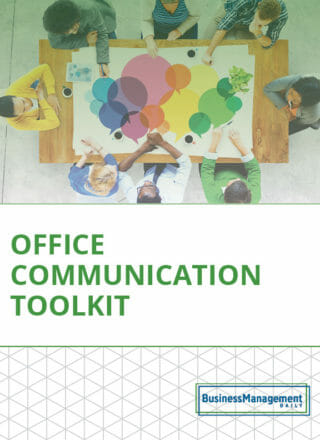Workplace boundaries: Examples to create a healthier work environment
 Do not equate the act of setting boundaries at work with selfishness. Instead, understand how work boundaries assist with performance and job satisfaction.
Do not equate the act of setting boundaries at work with selfishness. Instead, understand how work boundaries assist with performance and job satisfaction.
Boundaries allow you to maintain focus and stay on track. Additionally, they promote better mental health and work-life balance.
Furthermore, boundaries offer fellow team members guidelines on what makes you uncomfortable, leading to healthier work relationships.
What types of boundaries might you want to establish at work? The following examples present a variety of common work-related dilemmas and how setting healthy boundaries might aid in resolution.
Limiting interruptions
Bria realizes that being an administrative assistant involves a good deal of interaction with others. She takes pride in being helpful and even welcomes casual conversation. However, there are times when she really needs team members to leave her alone.
Compiling budgetary reports, for instance, demands intense focus. Losing concentration could lead to disastrous numerical errors. She wonders how to politely but firmly inform people to go away.
Boundary solutions: Bria could consider constructing some physical boundaries. Wearing noise-canceling headphones is a universal symbol of signaling to others not to bother you. If she has an office door, closing it when busy conveys the desire for privacy.
A “do not disturb until after (select time)” sign on a cubicle or desk also works. Plus, it tells those with questions when to return instead of them popping back every few minutes.
Bria might also benefit from setting a daily “power hour” during which she is unavailable. She can inform colleagues that she tackles her most detailed work during this time slot, and others will become accustomed to seeking her out before or after.
Avoiding physical contact
Emily does not enjoy hugging people outside of her immediate family. To her, it feels like an awkward invasion of personal space. Unfortunately, she works with numerous individuals who offer embraces on occasions such as birthdays or to celebrate the end of a project.
Emily used to intercept by extending her hand to shake. But since the pandemic, she prefers to avoid this type of contact. As the primary caregiver to her 85-year-old mother, Emily fears bringing germs home.
Boundary solutions: We all have different comfort levels regarding touch. If Emily makes her wishes known, colleagues will likely respect them. Communicating these types of boundaries can feel a bit weird, but once word gets out, everyone should be more at ease.
When Emily sees a co-worker with outstretched arms, she can say “not a hugger” and offer a warm smile, head nod, or slight bow instead. Similarly, stating, “I’m not comfortable with shaking hands,” is an appropriate response to an oncoming outstretched arm.
When Emily knows a handshake is likely, she can take the lead before discomfort. She can enthusiastically say, “I’m sorry. I do not shake hands but am so happy to meet you!”
And it should go without saying that nobody in the workplace should be subjected to a pat on the behind, a shove, or any other form of unprofessional contact. Crossing this boundary demands immediate attention.
State in no uncertain terms that the offender needs to stop. Consider notifying human resources if the act is severe or if the behavior persists.
Handling the “no subject is off limits” colleague
Want to know anything about anyone in the office? Ask Patricia. She has been around the company longer than most of its furniture. Her gift for gab can make new employees feel welcome or prove entertaining while waiting for a meeting to begin.
But it can also yield discomfort. Her co-worker Maria is especially bothered by Patricia’s inquiries about when she will start a family, which are usually followed by her highly detailed account of giving birth to her daughter.
Boundary solutions: Some employees like to share details of their personal lives and encourage others to be open books as well. In a work environment, though, everyone must respect professional boundaries. Such consideration is vital to psychological safety and the well-being of relationships.
Patricia needs to learn to read her audience and not overstep bounds. Maria and others can help her by presenting their personal boundaries. Maria can say, “I don’t feel comfortable discussing family planning with anyone but my husband.”
If Patricia gives pushback, Maria can calmly repeat her message and noticeably change the subject. (“Like I said, that’s a topic for a couple to discuss privately.
Let’s move on to thoughts on that new coffee shop that opened next door.”) Such a tactic also proves effective when stuck listening to TMI. (“Patricia, I hope your daughter gives you a wonderful present each Mother’s Day for what you went through in the delivery room. Now I want to know who has tried that cinnamon pumpkin latte.”)
Standing your ground is not always easy. However, as others witness you doing so, they may gain the courage to present their own boundaries, resulting in a better atmosphere.
Valuing self-care and healthy work-life balance
 Marcus considers himself a team player and a flexible employee. Lately, though, he wonders if he is setting himself up for burnout. He has worked through his lunch break for the past two weeks.
Marcus considers himself a team player and a flexible employee. Lately, though, he wonders if he is setting himself up for burnout. He has worked through his lunch break for the past two weeks.
The office is short-staffed, and his manager asked everyone to put forth extra effort. Marcus thinks he might have a sinus infection and would love to take a few sick days. He has PTO available, but he hesitates.
During his vacation last June, he received so many calls and texts that he hardly felt away from the office. Not that this scenario doesn’t play out routinely anyway.
Quite frequently, he just starts relaxing after hours, only to have his television show disturbed by notifications of work emails.
Boundary solutions: Dedication to work is admirable. But better boundaries need to be constructed when it starts interfering with one’s physical and mental well-being.
Think about it: How much of a star employee would you be if you allowed a medical problem to worsen? Or, do you really think your manager wants you to burnout to the point of quitting?
Take sick days without guilt as necessary. If there is pushback, firmly state that coming in when ill does not help anyone. Productivity will suffer, and errors become more likely. (Not to mention, the whole staff could come down with whatever you have if it’s something infectious.)
Think carefully about what you can tolerate regarding work hours both at the office and outside of it. Set limits. If you want a lunch break, let others know you are unavailable during this time. Head to the cafeteria or brown bag it at the park.
Likewise, establish clear boundaries about how early you can come in or how late you can stay. Resentment from needing to catch an earlier train or from paying fees for being late to daycare pick-up will eventually surface. It is better to establish time boundaries.
Employees thrive when they have manageable workloads, not unbearable ones. Instead of trying to compensate for the lack of staff, Marcus could discuss priorities with his boss.
Together, they can arrive at an accomplishable to-do list. If Marcus is saddled with tasks other than what has been agreed upon, he can refer back to that conversation and state that he cannot take on additional responsibilities.
Setting healthy boundaries applies to your free time, too. Just because others can communicate with you outside work does not mean they should. Prioritize relaxation and personal time.
Construct voicemail and work email messages that tell people you will get back to them during workday hours. Such a heads-up is courteous and gets others familiar with your schedule.
And definitely unplug while on vacation! When away from the office, truly be away. Let it be known that you won’t be checking messages or taking calls. Set up a co-worker in advance to cover pressing matters during your absence.
Successfully working from home
Allison enjoys telecommuting. She is very organized and self-motivated and feels more productive without office distractions. She keeps the television off to avoid being tempted to watch it and only uses social media and game apps at lunchtime.
The ability to run a load of clothes while she works is a definite plus, and the family finally adopted a dog because she is home to let it out as needed.
Lately, though, others have been disturbing Allison’s scheduled workday. She didn’t mind babysitting her niece once in a jam, but those “emergencies” have become more frequent.
She also has received texts from her kids at school asking her to drop off items they forgot. Even her husband sometimes doesn’t seem to understand how her hours are accounted for.
He left her a note on the fridge to buy more dog food today, even though he passes the pet store directly by on his way home.
Boundary solutions: Allison is doing a wonderful job of regulating her own boundaries, which can be quite challenging when working from home. She eliminates temptations and sets limitations to remain on task. Now, she needs to focus on setting healthy boundaries with her family.
People often do not think of home-based workers as “really” working. They envision that telecommuters can change their plans immediately or easily put off work-related projects until later.
They need guidance on what you can and cannot do. Communicate limits and schedules. Do not feel obligated to be the default babysitter or errand-runner.
Get used to saying “no,” “I can’t,” and “I won’t” to those who try to take advantage of your presence at home.
A final thing Allison and other diligent telecommuters must watch out for is the tendency to always feel “on.” To stop this mindset, establish boundaries between personal and professional realms.
Do not leave work-related material scattered throughout the house. Its presence promotes thinking of your work to-do list. Create rituals for calling it quits for the day, such as logging off the computer or closing the home office door.
For Allison, it might mean ceasing work when she hears her husband on the driveway closing his car door and getting dog food out of the trunk!
More resources:
Right to disconnect: Growing movement for work-life balance laws ![]()
Humor at work: Your guide to laughs without the gaffes ![]()
Workplace etiquette: The ultimate guide to professionalism ![]()




